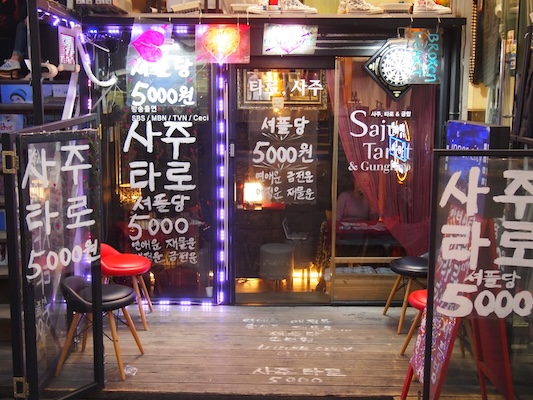Unveiling your destiny or seeking a glimpse into the future? Explore the diverse world of Korean fortune-telling! From Saju’s analysis of birth dates to face reading’s link between features and personality, discover unique methods. Find your perfect Korean fortune-telling method and embark on a journey of self-discovery!
Despite the religious restrictions prohibiting fortune telling, Korean locals are very interested in fortune telling. They take it as a form of entertainment and a guide for solving problems in their lives. There are many different types of fortune telling popular in Korea, starting from conventional saju to tarot from the West.
So, while you are in Korea, you can try out some of the local Korean fortune telling or try out others!
Types of Fortune Telling in Korea
Locals tend to visit fortune tellers near the end of year or until February to know more about the upcoming year. Some of the common questions asked include, “Is the coming year good for me?”, “Will I marry this year?”, or “Will I marry a good person?” and more.
What do you think you’ll ask when you visit any of the different fortune tellers in Korea?
There are many different types of fortune telling in South Korea. Some of the popular ones are saju (the local one), palmistry, face reading, tarot, and divination. You can try them all!
Saju
Saju is all about analyzing cosmic energy of an individual’s birth. It is based on the principle that one’s destiny cannot be changed and it all depends on your time, day, and year of birth. Locals also use it get information about marital compatibility or gunghap.
It’s the most popular form of fortune telling – it’s almost like Korean tarot.
Saju, also known as Four Pillars or Eight Characters, is a traditional Korean system of fortune-telling based on a person’s date and time of birth. It goes deeper than just a horoscope, incorporating a complex system of elements, energies, and cyclical patterns. The four pillars are year, month, day and hour. Each of these pillars includes two characters, making a total to be eight characters. And each of these characters have a yin or yang energy based on the five primary elements – wood, water, earth, metal, and fire.
In Seoul, finding Saju fortune telling is a breeze. Many shops and booths offering Saju consultations are conveniently located throughout the city. And most of them are generally affordable, with prices starting around 10,000 won. Saju cafes, featured on popular Korean TV shows, offer a unique atmosphere for your reading.

It’s important to note that many fortune tellers may not speak English. To ensure clear communication, consider bringing someone who speaks Korean with you during your consultation.
Palm Reading
Palm reading is also quite common way of fortune telling in Korea.
Palmistry involves study of palm where the reader focuses on shape of the palm, color, lines, and finger lengths. All these help in determining a person’s fate, love life, marriage, and more. Most Korean locals consider it a form of entertainment as it is much simpler.

Face Reading
Physiognomy or face reading is a popular option of fortune telling in South Korea that explores the connection between facial features and personality.
This belief system suggests that a person’s face reflects not only their character traits but also the influence of fate, genes, and lifestyle choices. Physiognomists believe facial features like the shape of your eyes, nose, or mouth can reveal aspects of your personality and potentially even hints about your destiny. It takes into the account your genetic history as there will be certain inherited traits. However, your life choices will leave their mark on your face.
In recent times, face reading is becoming. challenging as many Koreans are going under the knife to alter their facial features. Plastic surgery is as common as it could be in Korea. Some plastic surgeons even believe that changing features can change a person’s destiny.
Popularity of face reading is marked by the country even making a movie about it – “The Face Reader.” Starring Song Kang-ho, Lee Jung-jae, Lee Jong-suk, where Song can access the personality, mental state and habits of a person by looking at faces. Appearance (2008) is a comic book series about how to read a person’s face and it illustrates with several examples.
Can you feel the Korean passion for this way of fortune telling?
Tarot
While tarot cards have a long history in other cultures, their popularity in South Korea is a relatively recent. Whether you’re seeking specific guidance or a more general life overview, Korean tarot readers can cater to your needs.

You can search online or visit fortunetelling areas in cities like Seoul to find tarot card readers. Many Korean YouTubers also offer tarot readings on various topics, including love life.
Divination
Divination in Korea encompasses various methods, with shamanic practices offering a unique approach. Unlike Saju, which focuses on interpreting birth information, shamans employ rituals and techniques. They may attempt to attain insight into a person’s past, present, and future through divination practices. Based on this, shamans may offer spiritualistic guidance.
Can tourists and foreigners get saju fortune telling reading without having names in Chinese characters?
For those wondering if a Saju reading requires a name in Chinese characters, the answer is a resounding no! Saju practitioners rely solely on your birth date and exact time of birth to create your Saju chart. Saju focuses on the cyclical patterns of the Chinese calendar and the Five Elements theory. Your name, regardless of language, doesn’t factor into the equation.
All you need is your birthday and birth time to delve into the fascinating world of Korean fortune-telling through Saju.
Korean fortune telling in Seoul – with English translation
There are some places where you can get saju reading in English. If you are planning a visit, you can check out some saju cafes like Fun Saju near Hongik University in Seoul or Jaeminan Jogakga in Hongdae (서울 마포구 와우산로 21길 24).
Related Posts
8,667 total views, 4 views today

















